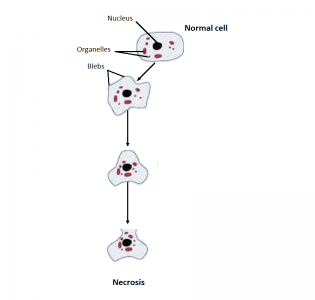Concept of necrosis
The term necrosis refers to non-apoptotic, i.e. non-programmed, cell death.
Cycle and cell death
During its life cycle, cell undergoes several morphologic and structural changes. These changes are known and are characterized and divided into phases: interphase (constituted by G1 phase, S phase and G2 phase) and M phse (constituted by mitosis and cytokinesis). Cells pass through the entire cell cycle, perform their function in a particular tissue/organ, and finally they have to die and be eliminated in order to avoid an accumulation of errors and the heritage of that errors to the offspring. The cell can resort to several processes of death: apoptosis, necrosis, oncosis and auphagy.
Necrosis’s characteristics
As noted above, unlike apoptosis, necrosis is not an event programmed by the cell. A cell goes through this event when it is a target of stress, has disturbances in its environment or is physically injured.
A cell in necrosis presents drastic morphological changes, which can be visualized through an optical microscope. This type is cell death is characterized by irreversible changes in the nucleus and cytoplasm (figure 1):
- cell swelling;
- condensation (pyknosis) and complete degradation (karyolysis) of the chromatin by the action of endonucleases;
- nucleus’s fragmentation and irregular distribution of chromatin throughout the cytosol (karyorrhexis);
- rapid homeostatic imbalance;
- loss of structure;
- fragmentation and lysis of the plasma membrane;
- release of the cellular content into the extracellular medium;
- inflammation of the surroundings and of neighbor cells.
Cell debris remaining in the extracellular medium are phagocyted by the cells of the immune system.

Figure 1 – Schematic image of changes occurred in the cell during cell death by necrosis.
Study of cells in necrosis
Loss of structural integrity is the hallmark of cell death by necrosis. This loss of structural integrity has specific biochemical characteristics: release of cytosolic enzymes, such as lactate dehydrogenase, and the ‘uptake’ of dyes, such as trypan blue and propidium iodite. By absorbing these dyes, it is possible to observe the cells in necrosis with the aid of the optical microscope.
References:
Bonfoco, E., Krainc, D., Ankarcrona, M., Nicotera, P., & Lipton, S. A. (August 1995). Apoptosis and Necrosis: Two Distinct Events Induced, Respectively, by Mild and Intense Insults with N-Methyl-D-Aspartate or Nitric Oxide/Superoxide in Cortical Cell Cultures. Proceedings of the National Academy of Sciences of the United States of America, 92:16, 7162-7166.
Degenhardt, K., Mathew, R., Beaudoin, B., Bray, K., Anderson, D., Chen, G., . . . Fan, Y. (July 2006). Autophagy promotes tumor cell survival and restricts necrosis, inflammation, and tumorigenesis. Cancer Cell, 10:1, 51-64.
Fink, S. L., & Cookson, B. T. (April 2005). Apoptosis, Pyroptosis, and Necrosis: Mechanistic Description of Dead and Dying Eukaryotic Cells. Infection and Immunity, 73:4, 1907-1916.
Majno, G., & Joris, I. (January 1995). Apoptosis, Oncosis, and Necrosis An Overview of Cell Death. American Journal ofPathology, 146:1, 3-15.




